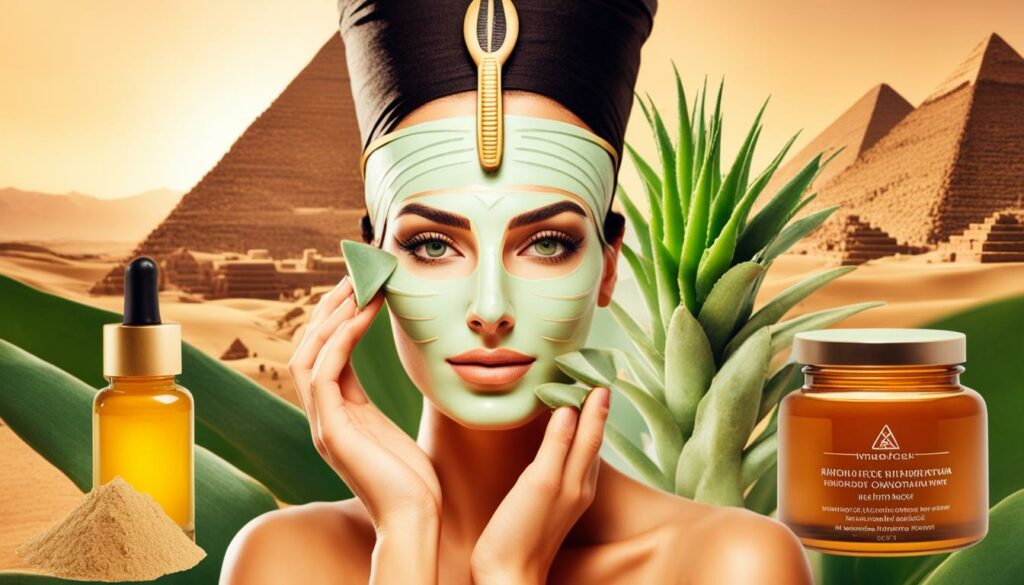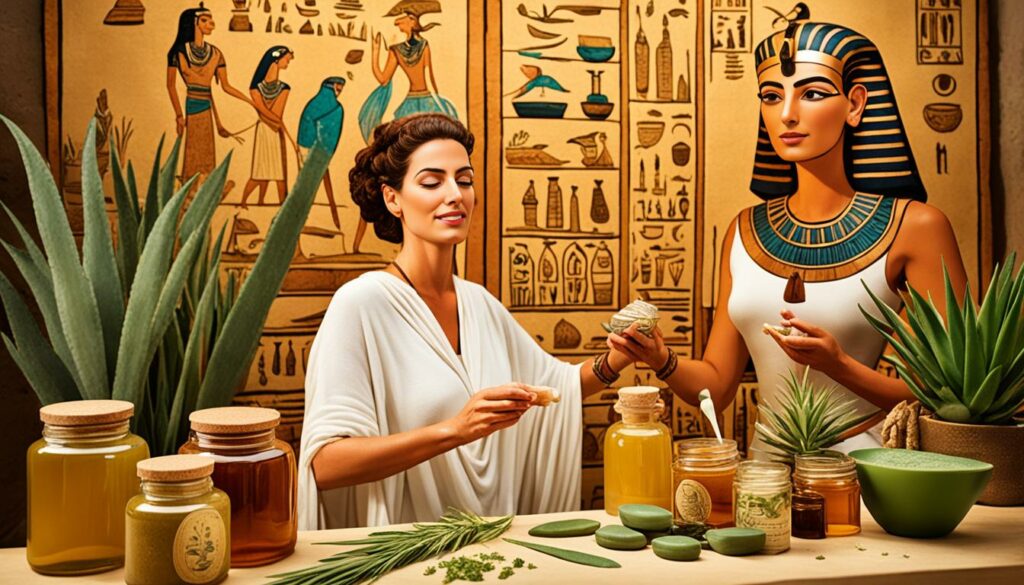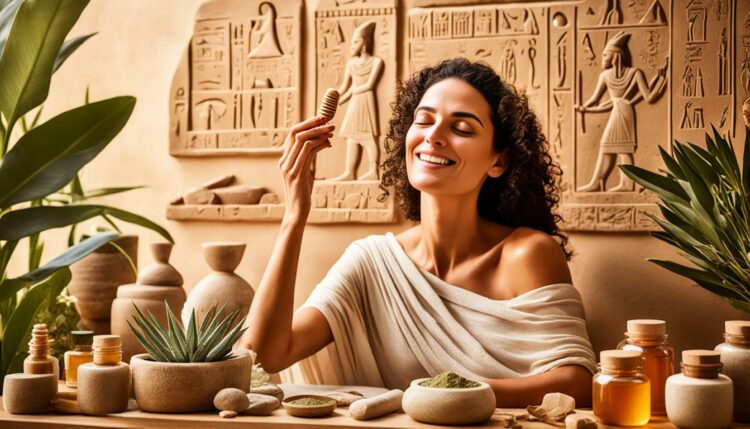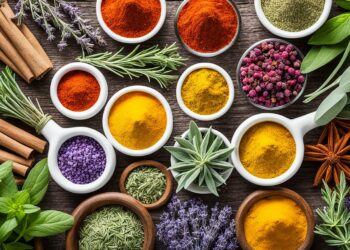Did you know that the ancient Egyptians were pioneers in the field of skincare and anti-aging practices? Their wisdom and knowledge in maintaining youthful and radiant skin have withstood the test of time.
From nourishing ingredients to exfoliation techniques, they had a range of natural beauty remedies that can still benefit us today. Let’s dive into the secrets of ancient Egyptian skincare and discover the timeless practices that can enhance our beauty routines.
The Importance of Diet in Ancient Egyptian Skincare
The ancient Egyptians believed that eating well was the key to looking good. Their diet was rich in pomegranate, dates, grapes, watermelon, garlic, cucumbers, carrots, celery, and peas, providing their bodies and skin with a plentiful source of antioxidants, protein, and fiber.
This nutritious diet played a vital role in maintaining healthy and radiant skin.
The ancient Egyptians particularly valued honey, and beekeeping began in ancient Egypt as early as 2400 BC. Honey was not only a sweet treat but also had beneficial properties when applied topically.
The hieroglyphics on ancient Egyptian walls depicted their food and drink choices, highlighting the importance of a well-rounded and nourishing diet in achieving good skin health.
Antioxidants: Powerful Skin Allies
Ancient Egyptian cuisine was abundant in fruits and vegetables, which are known for their high antioxidant content. Antioxidants help fight free radicals, which are unstable molecules that can cause damage to the skin cells.
By incorporating antioxidant-rich foods into their diet, the ancient Egyptians were able to protect their skin from oxidative stress and premature aging.
Protein: Essential for Skin Renewal
Protein is a crucial building block for the skin. It supports the production of collagen and elastin, which are responsible for maintaining the skin’s elasticity and firmness.
The ancient Egyptians obtained protein from sources such as legumes, peas, and certain types of fish, ensuring that their skin remained supple and youthful.
Fiber: Aiding Digestion and Skin Health
High-fiber foods were a staple in the ancient Egyptian diet. Fiber aids digestion and helps remove toxins from the body, promoting a healthy gut. A well-functioning digestive system contributes to overall skin health, as it can help prevent breakouts and improve the absorption of nutrients from food.
“The ancient Egyptians understood the importance of nourishing their bodies from the inside out. Their diet, rich in antioxidants, protein, and fiber, provided the perfect foundation for healthy and radiant skin.” – Dr. Aisha Hassan, Dermatologist
By following a balanced diet filled with antioxidant-rich foods, protein sources, and fiber, the ancient Egyptians were able to maintain vibrant and youthful-looking skin. The wisdom of their skincare practices serves as a reminder today that a holistic approach to skincare starts with nourishing our bodies through the foods we choose to consume.
Exfoliation Techniques of the Ancient Egyptians
The ancient Egyptians were pioneers in the field of skincare, and their knowledge of exfoliation techniques was no exception. They understood the importance of removing dead skin cells to reveal a more youthful complexion. Let’s explore the exfoliation methods used by the ancient Egyptians.
Pumice Stones: An Ancient Exfoliation Tool
One of the exfoliation tools used by the ancient Egyptians was the pumice stone. Derived from volcanic rock, pumice stones have a porous texture that makes them perfect for gently scrubbing away dead skin cells. The Egyptians would use these stones to buff their skin, leaving it smoother and revitalized.
Scrubs Made from Natural Ingredients
Ancient Egyptians also developed scrubs made from natural ingredients like sand and plants. For example, they would create scrubs using aloe vera, a plant known for its hydrating and soothing properties.
These scrubs were applied to the skin in gentle circular motions, effectively sloughing off dead skin cells and promoting a glowing complexion.
The Use of Natron
Natron, a mineral substance composed of sodium carbonate and water, was another popular exfoliant used by the ancient Egyptians.
They would mix Natron with water to create a scrub that would effectively remove dead skin cells. As a natural alkaline substance, Natron helped balance the skin’s pH levels and promote a healthy complexion.
Today, modern baking soda can be used as a mild substitute for Natron. It shares similar properties and can provide gentle exfoliation when mixed with water or other skincare ingredients.
Exfoliation is an essential step in any skincare routine. It helps remove dead skin cells, unclog pores, and improve the absorption of skincare products.
To achieve the best results, it is recommended to exfoliate no more than once a week. Over-exfoliating can lead to skin sensitivity and damage the skin’s natural barrier. By incorporating ancient Egyptian exfoliation techniques into our skincare routine, we can harness the wisdom of the past to achieve healthier, more radiant skin.
Benefits of Ancient Egyptian Exfoliation Techniques
Ancient Egyptian exfoliation techniques offer several benefits for the skin. By regularly exfoliating, you can:
- Remove dead skin cells and unclog pores
- Stimulate cell turnover for a more youthful complexion
- Improve the efficacy of skincare products
- Enhance the absorption of moisturizers and serums
These techniques have stood the test of time, and their effectiveness is still recognized today. Incorporating a gentle exfoliation routine into your skincare regimen can help you achieve the healthy and vibrant skin you desire.
Hair Removal Techniques of the Ancient Egyptians
Hair removal was a must for the ancient Egyptians, especially in the hot desert climate where they had no access to hygiene products like deodorants. They invented a method called sugaring, which is still popular today.
It involves using a paste made from a honey mixture to remove hair. Sugaring is considered more environmentally friendly and less painful than waxing because it binds to the hair rather than the skin. Some modern Egyptian women still use sugar and lime juice for hair removal instead of honey.
Ancient Egyptians valued hair removal for its practical benefits and aesthetics. In addition to managing body odor in the scorching heat, hair removal was also associated with cleanliness and social status in their culture.
The sugaring method, which originated in ancient Egypt, continues to be a preferred hair removal technique by many today.
“Sugaring is a gentle and effective way to remove hair. It is natural, chemical-free, and suitable for all skin types.”
The sugaring process involves creating a sticky paste by heating a mixture of sugar, water, and lemon juice or another acidic ingredient. Once the paste cools, it is spread on the skin in the direction of hair growth and then quickly pulled off, removing the hair from the root.
Unlike waxing, sugaring does not adhere to the skin, reducing the risk of irritation and damage to the skin’s surface.
Ancient Egyptian Sugaring Recipe
| Ingredients | Measurement |
|---|---|
| Sugar | 1 cup |
| Water | 2 tablespoons |
| Lemon Juice | 2 tablespoons |
To make the sugaring paste, mix the sugar, water, and lemon juice in a saucepan. Heat the mixture over medium heat, stirring constantly until the sugar dissolves and the mixture turns golden. Be careful not to overcook it, as it can quickly burn.
Once the paste has cooled to a comfortable temperature, apply it to the desired area, spreading it thinly in the direction of hair growth. Place a fabric strip or a piece of cotton cloth over the paste and press it down firmly. Finally, quickly pull off the fabric strip or cloth against the direction of hair growth to remove the hair.
Sugaring not only removes hair but also exfoliates the skin, leaving it smooth and rejuvenated. The natural ingredients used in sugaring are gentle on the skin, making it suitable for those with sensitive skin or allergies to waxing products.
While modern hair removal methods have evolved, the ancient Egyptian technique of sugaring remains a testament to their ingenuity and dedication to personal grooming. It is a timeless practice that continues to provide effective hair removal in a gentle and natural way.
Nourishing Ingredients for Youthful Skin in Ancient Egypt
The ancient Egyptians were renowned for their focus on beauty and skincare, utilizing a variety of natural ingredients to maintain youthful and radiant skin. This section explores some of the key nourishing ingredients that were integral to their skincare routines.
The Power of Avocado
Avocado, a nutrient-rich fruit, played a significant role in ancient Egyptian skincare. They would slice avocado and place it under their eyes to reduce dark circles and puffiness. The natural oils and antioxidants present in avocado nourish the delicate skin, giving it a vibrant and refreshed appearance.
Aloe Vera: The Plant of Immortality
Aloe vera was hailed as the “plant of immortality” by the ancient Egyptians for its remarkable nourishing and tightening properties. The gel extracted from aloe vera leaves provided vital hydration and soothing relief for the skin.
Its natural abundance of vitamins, minerals, and antioxidants helped stimulate collagen production, reduce inflammation, and protect against skin damage.
The Magic of Oils
Ancient Egyptians valued various oils for their moisturizing, anti-inflammatory, and healing effects. Oils such as frankincense, lupin seed, black seed, sesame, and fenugreek were commonly used in skincare rituals.
These oils contained essential vitamins, antioxidants, and fatty acids that deeply nourished the skin, promoting a youthful glow and combating signs of aging.
“The ancient Egyptians understood the transformative power of natural ingredients, harnessing their benefits for ageless and radiant skin.”
Ancient Egyptian skincare was centered around harnessing the potential of nature’s bountiful offerings. Ingredients like avocado, aloe vera, and an array of oils played an essential role in their quest for timeless beauty.
These natural remedies continue to be treasured for their ability to rejuvenate and restore, offering modern skincare enthusiasts a glimpse into the wisdom of the ancients.

Ancient Egyptian Skincare Ingredients:
| Ingredient | Benefits |
|---|---|
| Avocado | Nourishes, reduces dark circles and puffiness |
| Aloe Vera | Hydrates, tightens, stimulates collagen production |
| Oils (frankincense, lupin seed, black seed, sesame, fenugreek) | Moisturizes, anti-inflammatory, promotes healing |
Beauty Rituals for Cleansing and Hydration in Ancient Egypt
Ancient Egyptian queens Cleopatra and Nefertiti were renowned for their beauty and sought-after skincare secrets.
One of their favorite beauty rituals was indulging in luxurious milk and honey baths. These baths were not only a means of cleansing but also served as a powerful hydrating treatment, leaving their skin soft, supple, and glowing.
The combination of milk and honey offered unique benefits for the skin. Milk contains lactic acid, an alpha-hydroxy acid that gently exfoliates dead skin cells, revealing a smoother complexion. It also contains proteins, vitamins, and minerals that nourish and moisturize the skin.
Honey, on the other hand, is a natural humectant, drawing moisture from the air and locking it into the skin, providing deep hydration.
To recreate the ancient Egyptian beauty ritual in modern times, alternative options are available.
Coconut milk, when mixed with warm water, mimics the milk’s nourishing properties, making it an excellent substitute. Additionally, skincare products containing lactic acid can deliver the exfoliating benefits without the need for a milk bath.
Olive oil, another staple ingredient in ancient Egyptian beauty rituals, was widely used for cleansing the skin. It acted as an effective solvent, sticking to dirt and impurities, which were then scraped off, leaving the skin clean and nourished. Olive oil’s moisturizing properties further contributed to the overall rejuvenation of the skin.
| Ancient Egyptian Beauty Rituals | Benefits |
|---|---|
| Milk and Honey Baths | – Cleanses and moisturizes the skin |
| Olive Oil Cleansing | – Effective removal of dirt and impurities – Provides nourishment and hydration |
Although the ancient Egyptians might have had access to these natural ingredients in their purest form, modern alternatives can be easily incorporated into our skincare routines.
Whether it’s indulging in a coconut milk bath or using olive oil to cleanse the skin, these ancient beauty rituals can still provide us with the same cleansing and hydration benefits.
By drawing inspiration from the secrets of ancient Egypt, our skincare routines can become a journey back in time, unveiling the radiant beauty that lies within.
Skincare Practices in Different Time Periods
Skincare practices have evolved throughout history, with ancient civilizations and different time periods each contributing their unique approaches to beauty and self-care. From ancient Egypt to ancient Greece, medieval times, and the Renaissance, let’s explore the skincare practices that were popular in these distinct eras.
Ancient Egypt
In ancient Egypt, skincare was highly valued, and various natural ingredients were used to fight wrinkles and preserve youth. Castor, sesame, and moringa oils were prized for their nourishing and rejuvenating properties.
These oils were known for their ability to hydrate the skin, boost collagen production, and provide essential nutrients for a radiant complexion.
Ancient Greece
Ancient Greeks believed in the power of nature for skincare. Fresh berries, such as strawberries and blackberries, were used as natural exfoliants to remove dead skin cells and promote a healthy glow. Milk, particularly goat’s milk, was also a popular ingredient in skincare treatments, known for its moisturizing and brightening effects.
Medieval Times
During medieval times, herbal remedies played a significant role in skincare routines. Aloe vera, with its soothing and hydrating properties, was commonly used to cleanse and moisturize the skin.
Rosemary was favored for its astringent properties, helping to remove excess oil and tighten the pores. Cucumbers were also utilized to refresh and revitalize the skin.
The Renaissance
The Renaissance period saw a shift in skincare practices, with an emphasis on cosmetic enhancements. Silver mercury, lead, and chalk were used to whiten the face and create a pale complexion, which was considered a symbol of beauty and luxury.
However, these ingredients were highly toxic and had long-term detrimental effects on the skin.
Recent Times
In more recent times, there has been a growing awareness of the importance of natural and gentle skincare practices. Skincare products containing zinc oxide became popular for their sun protection properties, while all-natural remedies gained traction due to their minimal use of chemicals and focus on harnessing the power of botanical extracts.
It is fascinating to see how skincare practices have evolved over time, influenced by cultural beliefs, available resources, and advancements in science. Despite these variations, the fundamental goal of skincare remains constant – to nourish and care for the skin, contributing to its health and vitality.

Conclusion
The ancient Egyptians were pioneers in skincare and anti-aging practices, and their wisdom still holds relevance today. By incorporating elements of their historical skincare routines into our modern-day regimens, we can achieve healthier and more radiant skin.
One of the key takeaways from ancient Egyptian skincare is the use of natural beauty remedies. Ingredients like aloe vera, avocado, and various oils have nourishing and rejuvenating properties that can benefit our skin.
These natural remedies contain vitamins, antioxidants, and fatty acids that help stimulate collagen production, reduce inflammation, and protect against skin damage.
In addition to natural beauty remedies, the ancient Egyptians understood the importance of exfoliation and hair removal. Their exfoliation techniques using pumice stones and scrubs made from sand or aloe vera can help remove dead skin cells and promote a youthful complexion.
They also invented the method of sugaring for hair removal, which is still preferred by some today due to its effectiveness and gentleness on the skin.
Overall, ancient Egyptian anti-aging practices offer valuable insights and techniques for maintaining and improving skin health. By embracing these historical skincare rituals and incorporating them into our daily routines, we can harness the benefits of ancient wisdom and achieve timeless beauty.
FAQ
What were the skincare secrets of ancient Egyptians?
The ancient Egyptians had a wealth of skincare knowledge, including the use of nourishing ingredients, exfoliation techniques, hair removal methods, and cleansing rituals.
What was the importance of diet in ancient Egyptian skincare?
Good nutrition was believed to be key to looking good in ancient Egypt. Their diet was rich in antioxidants, protein, and fiber, with foods like pomegranate, dates, grapes, and garlic playing a significant role in maintaining healthy skin.
How did ancient Egyptians exfoliate their skin?
Ancient Egyptians used exfoliation methods such as pumice stones, scrubs made from sand or plants like aloe vera, and the use of Natron, a combination of sodium carbonate and water. Modern baking soda can be used as a substitute for Natron.
What hair removal techniques did ancient Egyptians use?
Hair removal was important for comfort in the hot desert climate, so ancient Egyptians invented a hair removal method called sugaring, which involved using a paste made from a honey mixture.
What were the nourishing ingredients used for youthful skin in ancient Egypt?
Ancient Egyptians used various nourishing ingredients like avocado, aloe vera, and oils such as frankincense, black seed, and sesame for their skincare routines. These ingredients were known for their moisturizing, anti-inflammatory, and healing effects.
What beauty rituals did ancient Egyptians follow for cleansing and hydration?
Ancient Egyptian queens Cleopatra and Nefertiti were known for their love of milk and honey baths, which cleansed and moisturized the skin. Olive oil was also used for cleansing purposes, sticking to dirt before being scraped off to leave the skin clean and nourished.
What skincare practices were followed in different time periods?
Skincare practices in ancient Egypt, ancient Greece, medieval times, and the Renaissance period differed. For example, in ancient Greece, fresh berries and milk were used for skincare treatments, while in medieval times, herbal remedies like aloe vera and cucumbers were popular.
What can we learn from ancient Egyptian skincare practices?
Incorporating elements of ancient Egyptian skincare into our routines can help achieve healthier, more radiant skin. From aloe vera to honey masks, these historical beauty remedies have stood the test of time.




